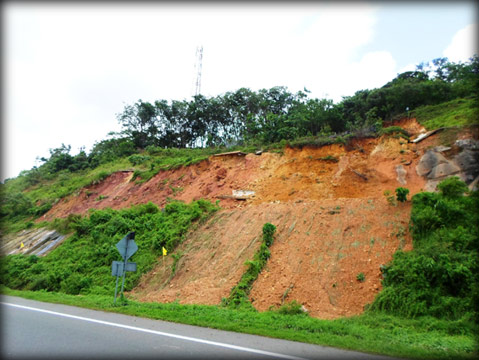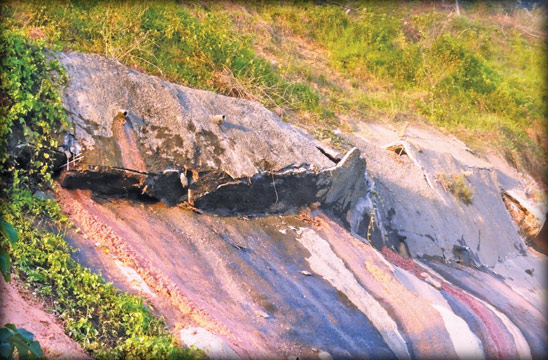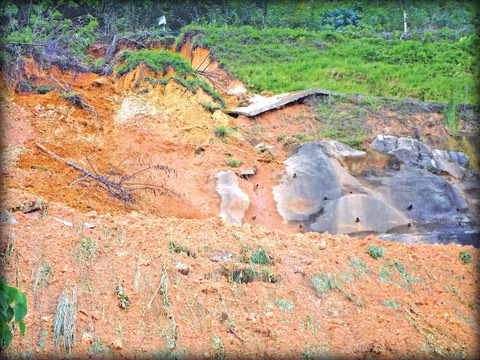 Decelerating
to detour Decelerating
to detour
The Kokmaduwa landslide, which forced the closure of
the Kokmaduwa-Imaduwa stretch of E01 has red-flagged many construction
and safety concerns :
The landslide at Kokmaduwa, which led to the Kokmaduwa – Imaduwa
stretch of the Southern Expressway (E01) being shut down for almost a
week, has red-flagged several pertinent questions about the 126.1
kilometre stretch of superhighway, primarily about preventive measures,
safety of motorists, and the quality of construction ensuring these
measures are fool proof.
|
E01
Southern Expressway
consists of 126.1 kilometres spanning from Kottawa to Matara.
The maximum operating speed for this section is 100 kmph.
The original plan was to extend the Expressway to Hambantota
with the intention of linking the Mattala Airport and
Hambantota Harbour to the Commercial Capital, Colombo. |
One would expect a super-highway, which sets a 100-km speed limit and
invites motorists to step on the gas, letting loose the hunger for
speed, to be proven and re-proven safe, no matter what the contingency.
Yet, since its inauspicious opening when wildlife from the area turned
out to menace the motorist, to certain stretches getting flooded every
time it rained, the expressway has turned ‘absolute’ into
‘questionable’. And the landslide debacle only serves to cement that
concern.
Experts in the field not only question the infrastructure provided
for the ‘Safety of the Motorists’ using the Expressway, but also the
quality of the construction.
Clearly visible
The ravages of the Kokmaduwa landslide is clearly visible to anyone,
driver or passenger, on the Expressway. The irony here is that the
landslide exposed, not just the ravaged landscape, but also the ‘so
called’ preventive measures undertaken earlier by the foreign contractor
or his local sub-contractor.
Inquiries made from the villagers living in the vicinity reveal that
around four to five years back, there was a landslide almost at the
exact same spot. The sliding earth piled up on the hard shoulder of the
Expressway, putting a dampener on the handing over of the Expressway to
the authorities.
 Billons
of rupees have been invested on the construction of the Expressway where
SAFETY of the travelling public – who pay a Toll Fee - is a vital
aspect; and the inconvenience to expressway users, caused by
obstructions cannot be measured in rupees and cents. Billons
of rupees have been invested on the construction of the Expressway where
SAFETY of the travelling public – who pay a Toll Fee - is a vital
aspect; and the inconvenience to expressway users, caused by
obstructions cannot be measured in rupees and cents.
‘Not a natural disaster’
There are accepted practices the world over in applying mitigatory
measures in the case of cuttings in the construction of Highways and
Railways- i.e. to prevent earthslides originating within the cutting,
obstructing the free movement of traffic. Various engineering methods
and proceedures are adopted by the Civil Engineers and Engineering
Consultants in charge of these projects and the client, the consultant
and the contractor are all responsible for failures.
In the context of the Kokmaduwa disaster, the question arises as to
who should be blamed and who should accept responsibility. Experts point
out that landslides such as what occurred in Kokmaduwa cannot be
considered a ‘Natural Disaster’ when massive amounts have been spent on
preventing such a disaster.
They point out that Sri Lankan Geological experts are quite
conversant and capable of handling such projects without subsequently
ending up in calamitous situations.
A Senior University Don expressing his views in the procedural forms
available for prevention of slides on cuttings, explained the general
procedure would be to do design drawings having checked up all relevant
data with regard to soil conditions, depth of soil cushion, moisture
content, rate of absorption of water, permeability, seepage, and rock
formations among other things.
 Having
studied the photographs he is of the opinion that the construction work
has been carried out haphazardly as indicated in the photographs in Soil
Nailing, linking up the nails at berm level, absence of paved berms with
drains, rock bolting, shotcreting the surface according to the
stipulated thickness and the absence of wire-netting, draining off of
ground water through horizontal drains, absence of proper surface water
drains,(damaged pieces of drains mirrors the standard of work of the
contractor), have not been undertaken as per correct design drawings and
the construction technology adopted is visibly very inferior. Having
studied the photographs he is of the opinion that the construction work
has been carried out haphazardly as indicated in the photographs in Soil
Nailing, linking up the nails at berm level, absence of paved berms with
drains, rock bolting, shotcreting the surface according to the
stipulated thickness and the absence of wire-netting, draining off of
ground water through horizontal drains, absence of proper surface water
drains,(damaged pieces of drains mirrors the standard of work of the
contractor), have not been undertaken as per correct design drawings and
the construction technology adopted is visibly very inferior.
Not an aberration
In the context of the above, the experts say there is an immediate
need for an inquiry to be conducted by a panel of experts from the
Universities of Peradeniya and Moratuwa and the National Building
Research Organization (NBRO) in fixing up of responsibility for the
damage and the subsequent cost involved in the remedial measures and to
recover the money spent, from those responsible.
This Panel, they say should study from the very first instance of the
landslide a few years back, the design drawing that are available with
NBRO; and determine whether these are acceptable as suitable: and
whether the contractor selected was suitably qualified and experienced
in such works; whether the contractor has conducted the work to
acceptable standards, whether he had engaged sub-contractors in the
work; whether sufficient supervision had been afforded; and whether the
work had been accepted and certified fit for payments – all of which
involved millions of Sri Lankan Rupees – as part of foreign loans. The
Kokmaduwa earth slip might have taken many by surprise, but there is no
guarantee it is going to be a one-off aberration, given the fact that
there exist many more earth slip prone areas, similar to Kokmaduwa along
the Southern Expressway.
Text and pix by Special Correspondent
| Looking for a
permanent solution
The Kokmaduwa – Imaduwa stretch of the
Southern Expressway that was closed for almost a week ago
due to a landslide threat, has been opened for traffic as
usual, confirms the Ministry of Highways. According to its
Secretary D.C. Dissanayake, the Expressway will be opened
for public as usual, but the Police, officials of the Road
Development Authority (RDA) and the National Building
Research Organisation (NBRO) will be on alert 24x7 working
on the spot. “Within few hours after the emergency close
down, the officials were able to reopen the expressway,”
Dissanayake said.
Assuring that as soon as the rain ceases,
officials of the RDA and the NBRO would start working on a
permanent solution, Dissanayake pointed out that all
measures have been taken to stabilise the area along the cut
slope.
The NBRO has fixed an early warning system
to detect any movement along the cuttings, which is linked
to an alarm system and to the traffic lights. “At any
emergency situation, the alarm system will get activated and
vehicles can be stopped until the situation is stable,” he
said.
Meanwhile officials of the RDA’s
Expressway Operation, Maintenance and Management Division,
claimed there was no significant drop in the number of
vehicles using Kokmaduwa- Imaduwa stretch of the Expressway.
“When the Expressway stretch is closed, vehicles exit from
the Kokmaduwa intersection and entre from Imaduwa. Therefore
vehicles can move almost in the normal way,” Acting
Director, R.A.D. Kahatapitiya, said
According to Kahatapitiya, the cut slope
is caused by the water flow of a manmade rainwater draining
system of a government estate, located at a higher
elevation, a few kilometres ahead of the affected spot. As
Kahatapitiya explained the water pressure building up
underneath the soil had affected the earth layers of the cut
slope to move.
He said the early warning system got
activated on October 2 and they were able to immediately
inform the police to stop and divert traffic.
The NBRO has established an operating room
functioning around the clock, located on the other side of
the Expressway, facing the site of the earth slip . An
extensometer, which is the main gadget of the early warning
system, has been fixed to the cut slope to detect movements.
The NBRO has also taken measures to lower
the water pressure in the soil. “The surface water draining
systems needed to be cleaned and cleared for the rain water
to properly drain,” said K.N. Bandara, head of the
Geotechnical Engineering and Testing Division of the NBRO,
adding that pipes have been drilled into earth to remove the
accumulating rain water under the ground.
“Water flowing from high elevations seems
to get accumulated under the soil surface and we have taken
necessary measures to drain this water out. Therefore at the
moment we have managed to lower the water pressure on the
loosened earth chunk,” explained Bandara, further
elaborating that ‘soil nailing’ could be a possible solution
to stabilise the cut slope. However, he said there was a
need to carry out a geotechnical and geophysical
investigations before coming to any conclusion. He also said
the NBRO is planning to start scientific investigations
within the next few days, to draft a detailed engineering
design for a long term solution.
-DY |
|

